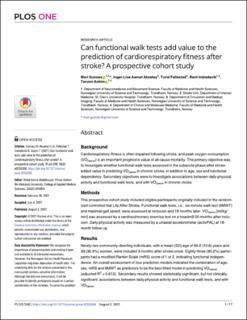| dc.description.abstract | Background Cardiorespiratory fitness is often impaired following stroke, and peak oxygen consumption (VO2peak) is an important prognostic value of all-cause mortality. The primary objective was to investigate whether functional walk tests assessed in the subacute phase after stroke added value in predicting VO2peak in chronic stroke, in addition to age, sex and functional dependency. Secondary objectives were to investigate associations between daily physical activity and functional walk tests, and with VO2peak in chronic stroke. Methods This prospective cohort study included eligible participants originally included in the randomized controlled trial Life After Stroke. Functional walk tests, i.e., six-minute walk test (6MWT) and maximal gait speed, were assessed at inclusion and 18 months later. VO2peak [ml/kg/min] was assessed by a cardiopulmonary exercise test on a treadmill 20 months after inclusion. Daily physical activity was measured by a uniaxial accelerometer (activPAL) at 18-month follow-up. Results Ninety-two community-dwelling individuals, with a mean (SD) age of 69.2 (10.6) years and 33 (35.9%) women, were included 3 months after stroke onset. Eighty-three (90.2%) participants had a modified Rankin Scale (mRS) score of 1 or 2, indicating functional independence. An overall assessment of four prediction models indicated the combination of age, sex, mRS and 6MWT as predictors to be the best fitted model in predicting VO2peak (adjusted R2 = 0.612). Secondary results showed statistically significant, but not clinically significant, associations between daily physical activity and functional walk tests, and with VO2peak. Conclusions 6MWT add significant value to the prediction of mean VO2peak in the chronic phase in mild strokes, in combination with age, sex and functional dependency. This prediction model may facilitate clinical decisions and rehabilitation strategies for mildly affected stroke survivors in risk of low levels of VO2peak. Future studies should validate the model in various stages after stroke and in patients moderately and severely affected. | en_US |

